翻译整理自:Top 50 ggplot2 Visualizations - The Master
List,有删改。
最后一部分了,希望一次完成🙈️。拖这么久主要是后面有些图不是很常用,所以没什么动力去仔细看。
4. Distribution
当数据量很大,我们只想看看数据分布情况。
Histogram
默认情况下,如果传给 ggplot2 只有一个参数,geom_bar() 会尝试将对这一列数据进行计数然后用计数来画条图。如果数据本身就是数值(不是数量)想用来直接画条图,可以使用 stat=identity 参数,但这个时候必须同时有 x/y 两个数据。
Histogram on a continuous variable
geom_bar() 或 geom_histogram() 多可以用来针对连续变量画条图。geom_histogram() 可以用 bins 参数控制图条的数量,也可以用 binwidth 设置图条对应的区间宽度。也因为 geom_histogram() 的参数更加灵活,所以画直方图是推荐用它的。
1
2
3
4
5
6
7
8
9
10
11
12
13
14
15
16
17
18
|
library(ggplot2)
theme_set(theme_classic())
# Histogram on a Continuous (Numeric) Variable
g <- ggplot(mpg, aes(displ)) + scale_fill_brewer(palette = "Spectral")
g + geom_histogram(aes(fill=class),
binwidth = .1,
col="black",
size=.1) + # change binwidth
labs(title="Histogram with Auto Binning",
subtitle="Engine Displacement across Vehicle Classes")
g + geom_histogram(aes(fill=class),
bins=5,
col="black",
size=.1) + # change number of bins
labs(title="Histogram with Fixed Bins",
subtitle="Engine Displacement across Vehicle Classes")
|
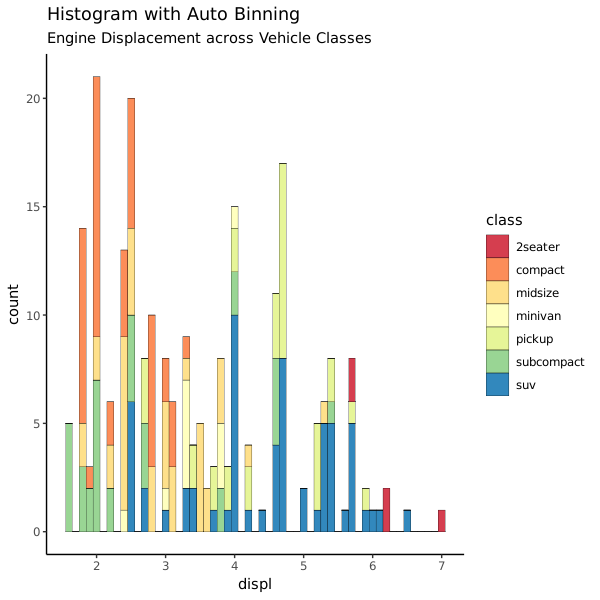
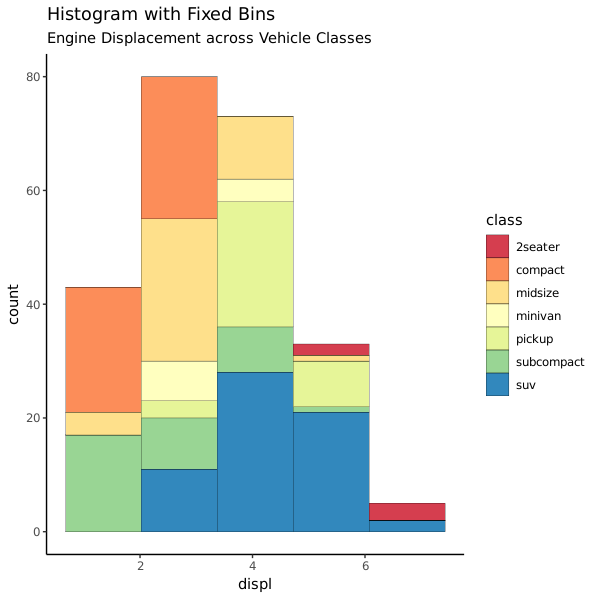
Histogram on a categorical variable
对分类变量画条图会得到各个类别的计数情况。通过调整 width 参数可以控制图条的宽度。
1
2
3
4
5
6
7
8
|
library(ggplot2)
theme_set(theme_classic())
# Histogram on a Categorical variable
g <- ggplot(mpg, aes(manufacturer))
g + geom_bar(aes(fill=class), width = 0.5) +
theme(axis.text.x = element_text(angle=65, vjust=0.6)) +
labs(title="Histogram on Categorical Variable",
subtitle="Manufacturer across Vehicle Classes")
|
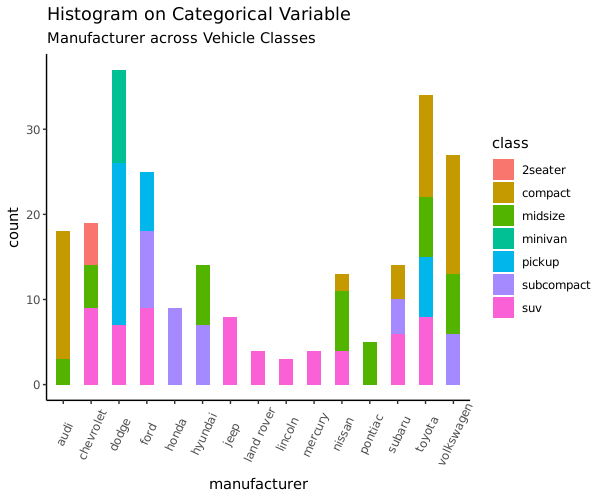
Density plot
密度图一般用来看连续性变量分布情况
1
2
3
4
5
6
7
8
9
10
|
library(ggplot2)
theme_set(theme_classic())
# Plot
g <- ggplot(mpg, aes(cty))
g + geom_density(aes(fill=factor(cyl)), alpha=0.8) +
labs(title="Density plot",
subtitle="City Mileage Grouped by Number of cylinders",
caption="Source: mpg",
x="City Mileage",
fill="# Cylinders")
|
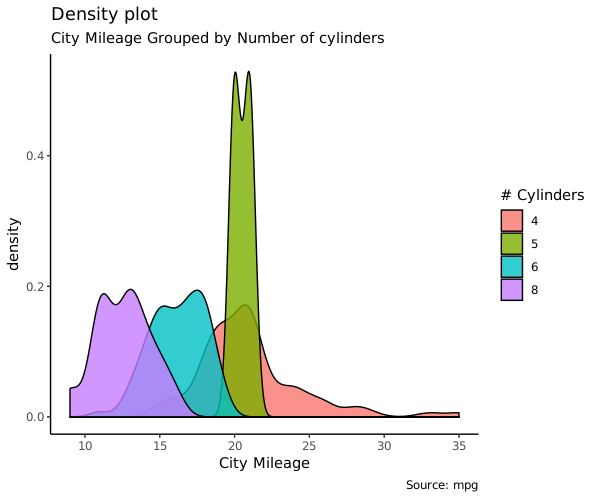
Box Plot
箱式图也是展示数据分布的好办法。箱式图同时展示了中位数、上下限以及离群点:箱子内的横线是中位数,上下边分别是 75% 和 25% 分位值,箱子两端上下的线表示 1.5*IQR (Inter Quartile Range,表示 25% 和 75% 之间的距离),这之外的数据一般用点画出来,表示离群点。
varwidth=TRUE 可以让箱子的宽度反映出箱子代表的数据点的多少。
1
2
3
4
5
6
7
8
9
10
|
library(ggplot2)
theme_set(theme_classic())
# Plot
g <- ggplot(mpg, aes(class, cty))
g + geom_boxplot(varwidth=T, fill="plum") +
labs(title="Box plot",
subtitle="City Mileage grouped by Class of vehicle",
caption="Source: mpg",
x="Class of Vehicle",
y="City Mileage")
|
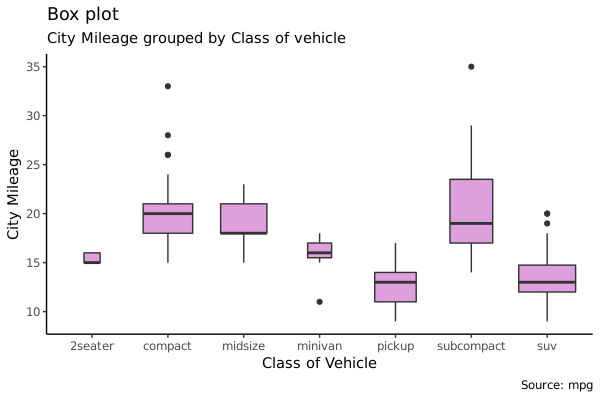
1
2
3
4
5
6
7
8
9
|
library(ggthemes)
g <- ggplot(mpg, aes(class, cty))
g + geom_boxplot(aes(fill=factor(cyl))) +
theme(axis.text.x = element_text(angle=65, vjust=0.6)) +
labs(title="Box plot",
subtitle="City Mileage grouped by Class of vehicle",
caption="Source: mpg",
x="Class of Vehicle",
y="City Mileage")
|
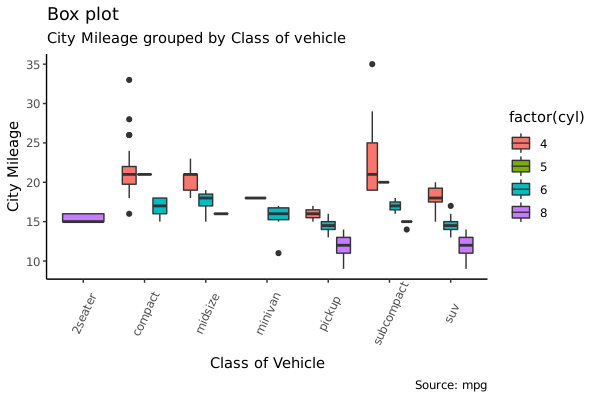
Dot + Box Plot
在箱式图的基础上,还可以把数据点叠加上来。
1
2
3
4
5
6
7
8
9
10
11
12
13
14
15
16
|
library(ggplot2)
theme_set(theme_bw())
# plot
g <- ggplot(mpg, aes(manufacturer, cty))
g + geom_boxplot() +
geom_dotplot(binaxis='y',
stackdir='center',
dotsize = .5,
fill="red") +
theme(axis.text.x = element_text(angle=65, vjust=0.6)) +
labs(title="Box plot + Dot plot",
subtitle="City Mileage vs Class: Each dot represents 1 row in source data",
caption="Source: mpg",
x="Class of Vehicle",
y="City Mileage")
|
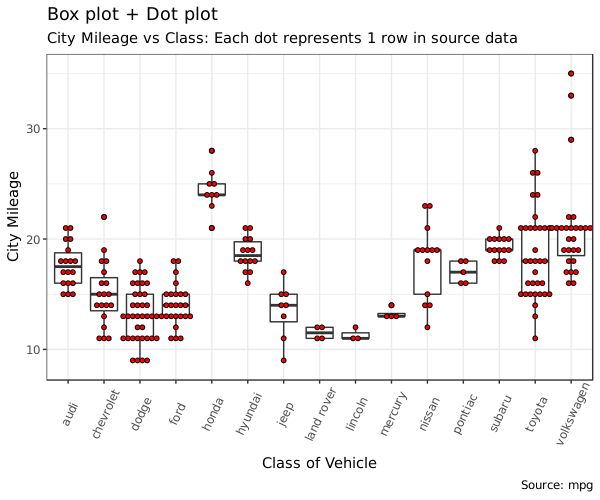
Tufte Boxplot
Tufte 箱式图是基于 Edward Tufte 的可视化理论的一种图,由 ggthemes 提供的。它是一种极简同时又更美观的箱式图。
1
2
3
4
5
6
7
8
9
10
11
12
13
|
library(ggthemes)
library(ggplot2)
theme_set(theme_tufte()) # from ggthemes
# plot
g <- ggplot(mpg, aes(manufacturer, cty))
g + geom_tufteboxplot() +
theme(axis.text.x = element_text(angle=65, vjust=0.6)) +
labs(title="Tufte Styled Boxplot",
subtitle="City Mileage grouped by Class of vehicle",
caption="Source: mpg",
x="Class of Vehicle",
y="City Mileage")
|
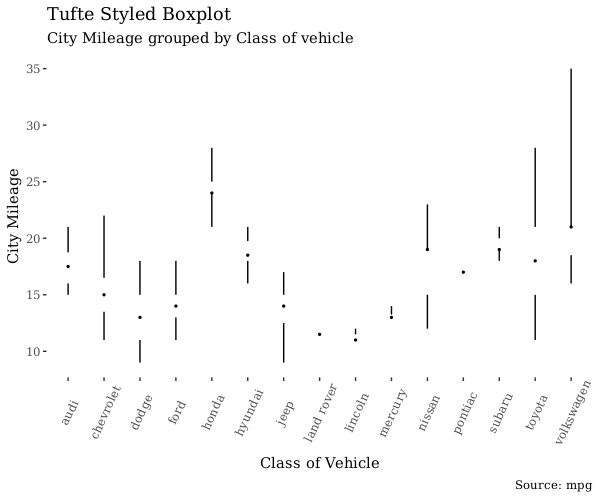
Violin Plot
小提琴图和箱式图类似,增加了数据的密度信息的展示,这是箱式图所没有的。
1
2
3
4
5
6
7
8
9
10
11
|
library(ggplot2)
theme_set(theme_bw())
# plot
g <- ggplot(mpg, aes(class, cty))
g + geom_violin() +
labs(title="Violin plot",
subtitle="City Mileage vs Class of vehicle",
caption="Source: mpg",
x="Class of Vehicle",
y="City Mileage")
|

Population Pyramid
人口金字塔,展示各类别人口或者人口百分比的一种图形。下面的图是展示的是邮件促销活动中各个阶段用户量的情况:
1
2
3
4
5
6
7
8
9
10
11
12
13
14
15
16
17
18
19
20
21
22
23
24
25
|
library(ggplot2)
library(ggthemes)
options(scipen = 999) # turns of scientific notations like 1e+40
# Read data
email_campaign_funnel <-
read.csv(
"https://raw.githubusercontent.com/selva86/datasets/master/email_campaign_funnel.csv"
)
# X Axis Breaks and Labels
brks <- seq(-15000000, 15000000, 5000000)
lbls = paste0(as.character(c(seq(15, 0, -5), seq(5, 15, 5))), "m")
# Plot
ggplot(email_campaign_funnel, aes(x = Stage, y = Users, fill = Gender)) + # Fill column
geom_bar(stat = "identity", width = .6) + # draw the bars
scale_y_continuous(breaks = brks, # Breaks
labels = lbls) + # Labels
coord_flip() + # Flip axes
labs(title = "Email Campaign Funnel") +
theme_tufte() + # Tufte theme from ggfortify
theme(plot.title = element_text(hjust = .5),
axis.ticks = element_blank()) + # Centre plot title
scale_fill_brewer(palette = "Dark2") # Color palette
|
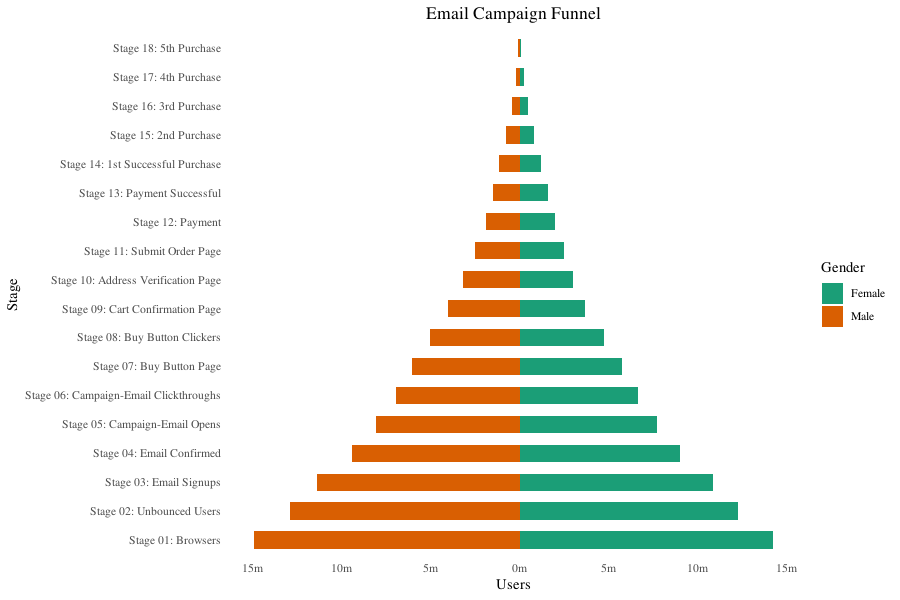
画这个图的技巧是把不同两组数据画条图在一幅图中,但是其中一个数值改为负值。
5. Composition
Waffle Chart
华夫图用来展示总体中不同类别组成情况的。ggplot 没有提供这个功能,但是我们可以用 geom_tile() 实现这个:
1
2
3
4
5
6
7
8
9
10
11
12
13
14
15
16
17
18
19
20
21
22
23
24
25
26
27
28
29
|
var <- mpg$class # the categorical data
## Prep data (nothing to change here)
nrows <- 10
df <- expand.grid(y = 1:nrows, x = 1:nrows)
categ_table <- round(table(var) * ((nrows * nrows) / (length(var))))
categ_table
df$category <- factor(rep(names(categ_table), categ_table))
# NOTE: if sum(categ_table) is not 100 (i.e. nrows^2), it will need adjustment to make the sum to 100.
## Plot
ggplot(df, aes(x = x, y = y, fill = category)) +
geom_tile(color = "black", size = 0.5) +
scale_x_continuous(expand = c(0, 0)) +
scale_y_continuous(expand = c(0, 0), trans = 'reverse') +
scale_fill_brewer(palette = "Set3") +
labs(title = "Waffle Chart",
subtitle = "'Class' of vehicles",
caption = "Source: mpg") +
theme(
panel.border = element_rect(size = 2),
plot.title = element_text(size = rel(1.2)),
axis.text = element_blank(),
axis.title = element_blank(),
axis.ticks = element_blank(),
legend.title = element_blank(),
legend.position = "right"
) +
theme_dark()
|

Pie Chart
饼图就很熟悉了。但是 ggplot2 画饼图有一点点小难,用到的是 coord_polar():
1
2
3
4
5
6
7
8
9
10
11
12
13
14
15
16
17
18
19
|
library(ggplot2)
theme_set(theme_classic())
# Source: Frequency table
df <- as.data.frame(table(mpg$class))
colnames(df) <- c("class", "freq")
pie <- ggplot(df, aes(x = "", y = freq, fill = factor(class))) +
geom_bar(width = 1, stat = "identity") +
theme(axis.line = element_blank(),
plot.title = element_text(hjust = 0.5)) +
labs(
fill = "class",
x = NULL,
y = NULL,
title = "Pie Chart of class",
caption = "Source: mpg"
)
pie + coord_polar(theta = "y", start = 0)
|
这是当数据是频数资料的时候的画法。下面则是数据是原始分类数据的时候的画法:
1
2
3
4
5
6
7
8
9
10
11
12
13
14
15
|
# Source: Categorical variable.
# mpg$class
pie <- ggplot(mpg, aes(x = "", fill = factor(class))) +
geom_bar(width = 1) +
theme(axis.line = element_blank(),
plot.title = element_text(hjust = 0.5)) +
labs(
fill = "class",
x = NULL,
y = NULL,
title = "Pie Chart of class",
caption = "Source: mpg"
)
pie + coord_polar(theta = "y", start = 0)
|
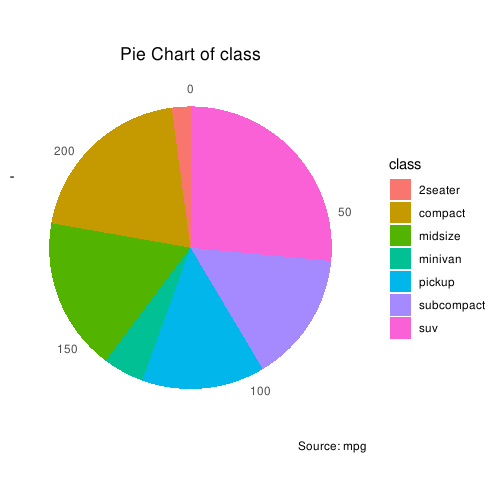
和饼图类似的是甜甜圈图(Donut plot),下面的例子来自 Most basic doughnut chart with ggplot2(这个帖子也很有意思,值得一看):
1
2
3
4
5
6
7
8
9
10
11
12
13
14
15
16
17
18
19
20
21
22
23
24
25
26
27
28
29
30
31
32
33
|
# load library
library(ggplot2)
# Create test data.
data <- data.frame(category = c("A", "B", "C"),
count = c(10, 60, 30))
# Compute percentages
data$fraction <- data$count / sum(data$count)
# Compute the cumulative percentages (top of each rectangle)
data$ymax <- cumsum(data$fraction)
# Compute the bottom of each rectangle
data$ymin <- c(0, head(data$ymax, n = -1))
# Compute label position
data$labelPosition <- (data$ymax + data$ymin) / 2
# Compute a good label
data$label <- paste0(data$category, "\n value: ", data$count)
# Make the plot
ggplot(data, aes(
ymax = ymax,
ymin = ymin,
xmax = 4,
xmin = 3,
fill = category
)) +
geom_rect() +
geom_label(x = 3.5,
aes(y = labelPosition, label = label),
size = 5) +
scale_fill_brewer(palette = 4) +
coord_polar(theta = "y") +
xlim(c(2, 4)) +
theme_void() +
theme(legend.position = "none")
|
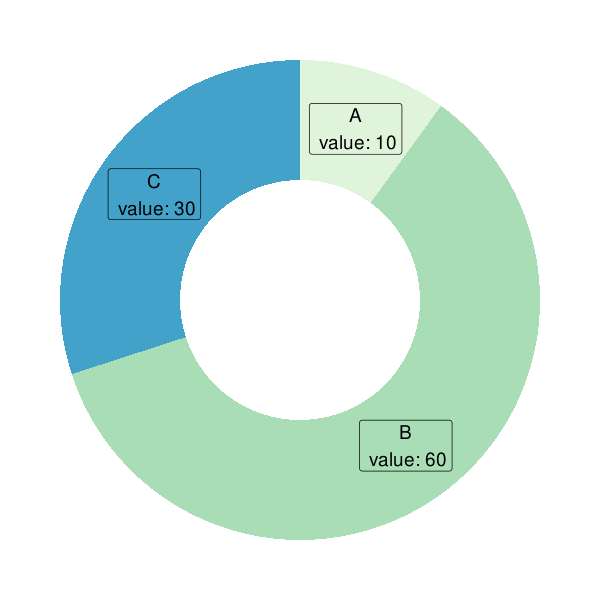
Treemap
略。
Bar Chart
默认情况下,geom_bar() 的 stat 设置为 count。这导致当只提供一个连续型数据作为 X 变量而不提供 Y 时会得到一个直方图。要画直条图而不是直方图,需要两个数据:
- 设置
stat = identity
- 提示提供 X 和 Y 并且设置到
aes() 里,X 是因子型或者字符型,Y 是数值型。
直接用一列分类型数据或者整理好的频数表都可以画条图。width 参数可以调整条的宽度。如果数据已经是整理好的频数资料,那就需要在 geom_bar() 里设置 stat = identity。
1
2
3
4
5
6
7
8
9
10
11
12
13
14
15
16
17
18
19
20
21
|
library("ggplot2")
# prep frequency table
freqtable <- table(mpg$manufacturer)
df <- as.data.frame.table(freqtable)
head(df)
# Var1 Freq
# 1 audi 18
# 2 chevrolet 19
# 3 dodge 37
# 4 ford 25
# 5 honda 9
# 6 hyundai 14
theme_set(theme_classic())
# Plot
g <- ggplot(df, aes(Var1, Freq))
g + geom_bar(stat = "identity", width = 0.5, fill = "tomato2") +
labs(title = "Bar Chart",
subtitle = "Manufacturer of vehicles",
caption = "Source: Frequency of Manufacturers from 'mpg' dataset") +
theme(axis.text.x = element_text(angle = 65, vjust = 0.6))
|
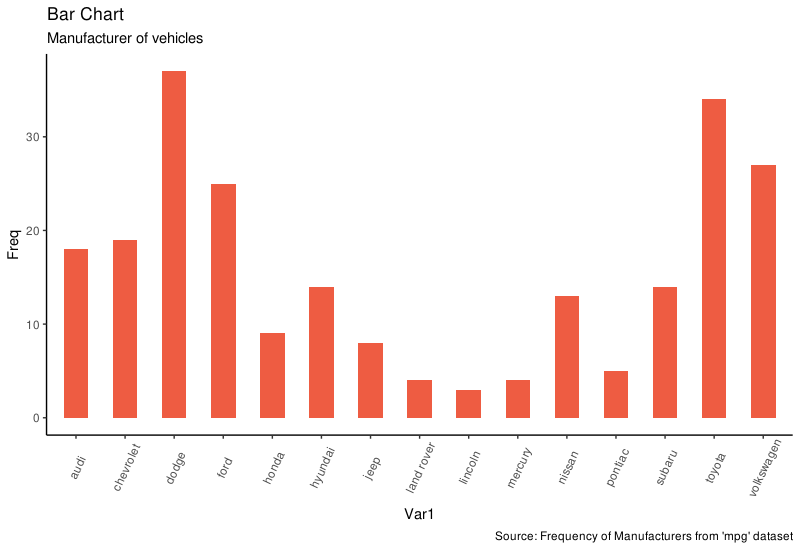
其实不提供计算好的频数表,ggplot 也能自己计算频数然后画图。这时候只需要提供 X 变量就可以,同时不要设置 stat = identity:
1
2
3
4
5
6
7
|
# From on a categorical column variable
g <- ggplot(mpg, aes(manufacturer))
g + geom_bar(aes(fill = class), width = 0.5) +
theme(axis.text.x = element_text(angle = 65, vjust = 0.6)) +
labs(title = "Categorywise Bar Chart",
subtitle = "Manufacturer of vehicles",
caption = "Source: Manufacturers from 'mpg' dataset")
|

6. Change
这里的改变都是指随时间改变的时间序列数据。
Time Series Plot From a Time Series Object (ts)
ggfortify 包可以识别时间序列对象直接自动作图:
1
2
3
4
5
6
7
8
9
|
## From Timeseries object (ts)
library("ggplot2")
library("ggfortify")
theme_set(theme_classic())
# Plot
autoplot(AirPassengers) +
labs(title = "AirPassengers") +
theme(plot.title = element_text(hjust = 0.5))
|
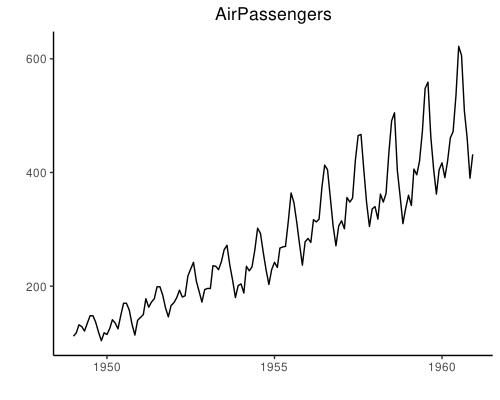
Time Series Plot From a Data Frame
geom_line() 可以直接使用数据框画时间序列的线图。这时候 X 轴会根据数据自动生成。下面的例子里 X 轴自动在每 10 年的位置生成了一个刻度。
1
2
3
4
5
6
7
8
9
10
11
12
13
14
15
16
17
18
19
20
21
22
23
24
25
26
|
library("ggplot2")
theme_set(theme_classic())
data("economics")
head(economics)
# # A tibble: 6 x 6
# date pce pop psavert uempmed unemploy
# <date> <dbl> <dbl> <dbl> <dbl> <dbl>
# 1 1967-07-01 507. 198712 12.6 4.5 2944
# 2 1967-08-01 510. 198911 12.6 4.7 2945
# 3 1967-09-01 516. 199113 11.9 4.6 2958
# 4 1967-10-01 512. 199311 12.9 4.9 3143
# 5 1967-11-01 517. 199498 12.8 4.7 3066
# 6 1967-12-01 525. 199657 11.8 4.8 3018
economics$returns_perc <-
c(0,
diff(economics$psavert) / economics$psavert[-length(economics$psavert)])
# Allow Default X Axis Labels
ggplot(economics, aes(x = date)) +
geom_line(aes(y = returns_perc)) +
labs(
title = "Time Series Chart",
subtitle = "Returns Percentage from 'Economics' Dataset",
caption = "Source: Economics",
y = "Returns %")
|
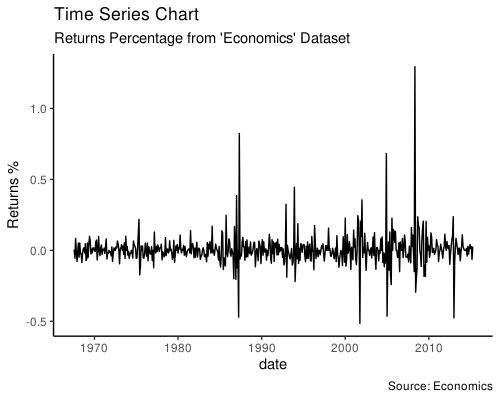
Time Series Plot For a Monthly Time Series
如果对自动生成的时间刻度不满意,可以用 scale_x_date() 分别指定 breaks 和 labels 来设置新的 X 轴:
1
2
3
4
5
6
7
8
9
10
11
12
13
14
15
16
17
18
19
20
21
22
23
24
25
26
27
|
library("ggplot2")
library("lubridate")
theme_set(theme_bw())
economics_m <- economics[1:24,]
# labels and breaks for X axis text
lbls <-
paste0(month.abb[month(economics_m$date)],
" ",
lubridate::year(economics_m$date))
brks <- economics_m$date
# plot
ggplot(economics_m, aes(x = date)) +
geom_line(aes(y = returns_perc)) +
labs(
title = "Monthly Time Series",
subtitle = "Returns Percentage from Economics Dataset",
caption = "Source: Economics",
y = "Returns %"
) + # title and caption
scale_x_date(labels = lbls,
breaks = brks) + # change to monthly ticks and labels
theme(axis.text.x = element_text(angle = 90, vjust = 0.5),
# rotate x axis text
panel.grid.minor = element_blank()) # turn off minor grid
|
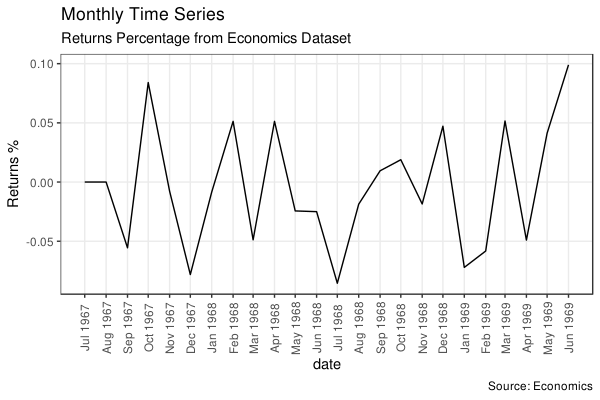
Time Series Plot For a Yearly Time Series
既然能自定义为按月作图,自然也就可以定义为按年作图了。做法和上面一样:
1
2
3
4
5
6
7
8
9
10
11
12
13
14
15
16
17
18
19
20
21
22
23
24
|
library("ggplot2")
library("lubridate")
theme_set(theme_bw())
economics_y <- economics[1:90,]
# labels and breaks for X axis text
brks <- economics_y$date[seq(1, length(economics_y$date), 12)]
lbls <- lubridate::year(brks)
# plot
ggplot(economics_y, aes(x = date)) +
geom_line(aes(y = returns_perc)) +
labs(
title = "Yearly Time Series",
subtitle = "Returns Percentage from Economics Dataset",
caption = "Source: Economics",
y = "Returns %"
) + # title and caption
scale_x_date(labels = lbls,
breaks = brks) + # change to monthly ticks and labels
theme(axis.text.x = element_text(angle = 90, vjust = 0.5),
# rotate x axis text
panel.grid.minor = element_blank()) # turn off minor grid
|
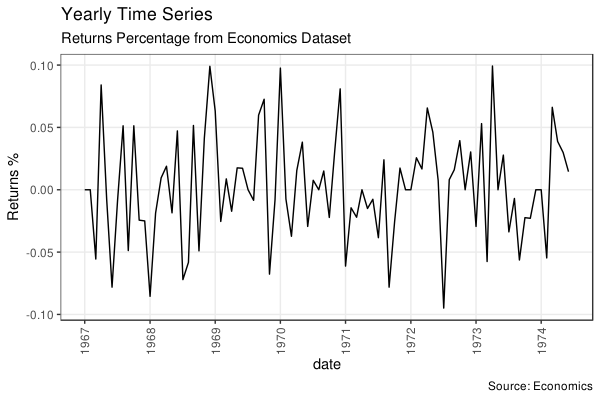
长数据形式就是说主要的数据只有两列,一列表示变量名,另一列是值。下面的例子我们用上面的 economics 长数据形式 economics_long,当然因为还有一个时间序列用来做 X 轴,所以这个数据是三列。
1
2
3
4
5
6
7
8
9
10
11
12
13
14
15
16
17
18
19
20
21
22
23
24
25
26
27
28
29
30
31
32
33
34
35
36
37
38
39
40
41
42
43
44
45
46
47
48
49
|
library("ggplot2")
library("lubridate")
theme_set(theme_bw())
data(economics_long, package = "ggplot2")
head(economics_long)
# # A tibble: 6 x 4
# date variable value value01
# <date> <chr> <dbl> <dbl>
# 1 1967-07-01 pce 507. 0
# 2 1967-08-01 pce 510. 0.000265
# 3 1967-09-01 pce 516. 0.000762
# 4 1967-10-01 pce 512. 0.000471
# 5 1967-11-01 pce 517. 0.000916
# 6 1967-12-01 pce 525. 0.00157
df <-
economics_long[economics_long$variable %in% c("psavert", "uempmed"),]
df <- df[lubridate::year(df$date) %in% c(1967:1981),]
# labels and breaks for X axis text
brks <- df$date[seq(1, length(df$date), 12)]
lbls <- lubridate::year(brks)
# plot
ggplot(df, aes(x = date)) +
geom_line(aes(y = value, col = variable)) +
labs(
title = "Time Series of Returns Percentage",
subtitle = "Drawn from Long Data format",
caption = "Source: Economics",
y = "Returns %",
color = NULL
) + # title and caption
# change to monthly ticks and labels
scale_x_date(labels = lbls, breaks = brks) +
scale_color_manual(
labels = c("psavert", "uempmed"),
values = c("psavert" = "#00ba38", "uempmed" = "#f8766d")
) + # line color
theme(
axis.text.x = element_text(
angle = 90,
vjust = 0.5,
size = 8
),
# rotate x axis text
panel.grid.minor = element_blank()
) # turn off minor grid
|

前面提到过,作图的时候只要依据一列数据通过 geom 改变了图的几何特性(点的形状/大小/颜色,线的粗细/类型/颜色等等),ggplot 都会自动生成一个对应的图例。
但是当我们是用时间序列组图的时候是自己一次一次的调用 geom_line() 一条一条画线,所以这时候并没有自动生成图例。偏偏这时候一般确实又是需要有图例给不同的线做解释的。这时候就可以用 scale_aesthetic_manual() 这些函数来自己加上图例(比如如果只改了线的颜色那就可以用 scale_color_manual())。这时候还可以通过分别通过 name 和 values 参数指定图例的标题和和作图的颜色。
下面我们会作出一张和刚刚上面长数据出来的一模一样的图,但是看代码就知道事实上所用的方法确是完全不一样的。在长数据作图中虽然也用到了 scale_color_manual(),但是在那里这个函数仅仅是为了改变线条颜色而已,不用这个函数上面的图也会有图例生成,只是图会使用 ggplot 的默认颜色而已。但是在这里的例子里如果不使用 scale_color_manual() 的话图根本不会有图例生成。(事实上我自己试了这里即使注释掉 scale_color_manual() 函数出来的图还是有图例的,只是线条颜色确实会变成 ggplot 默认颜色而已而且图例标题不会去掉而已,我猜这可能是 ggplot 在更新过程中加入了这一功能)
1
2
3
4
5
6
7
8
9
10
11
12
13
14
15
16
17
18
19
20
21
22
23
24
25
|
library("ggplot2")
library("lubridate")
theme_set(theme_bw())
df <- economics[, c("date", "psavert", "uempmed")]
df <- df[lubridate::year(df$date) %in% c(1967:1981),]
# labels and breaks for X axis text
brks <- df$date[seq(1, length(df$date), 12)]
lbls <- lubridate::year(brks)
# plot
ggplot(df, aes(x = date)) +
geom_line(aes(y = psavert, col = "psavert")) +
geom_line(aes(y = uempmed, col = "uempmed")) +
labs(
title = "Time Series of Returns Percentage",
subtitle = "Drawn From Wide Data format",
caption = "Source: Economics",
y = "Returns %"
) + # title and caption
scale_x_date(labels = lbls, breaks = brks) + # change to monthly ticks and labels
scale_color_manual(name = "",
values = c("psavert" = "#00ba38", "uempmed" = "#f8766d")) + # line color
theme(panel.grid.minor = element_blank()) # turn off minor grid
|
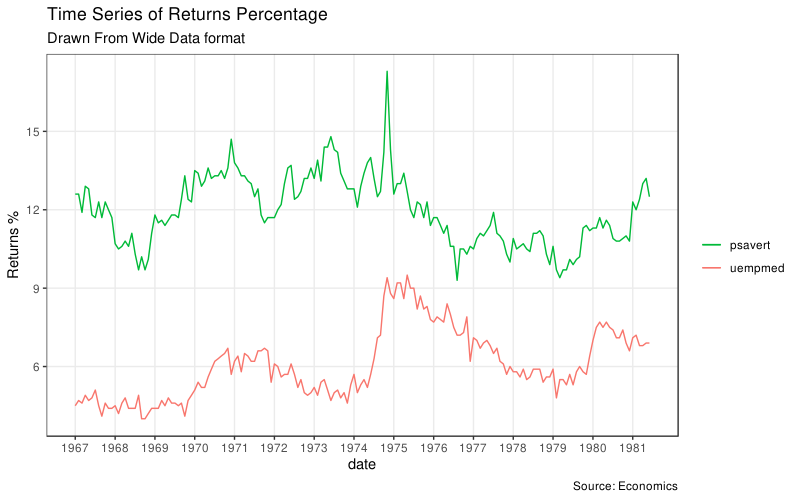
Stacked Area Chart
略。
Calendar Heatmap
略。
Slope Chart
坡度图很适合用于展示数值的变化情况以及不同类别的排序。当时间序列数据但是时间点很少的时候也很适合用坡度图。
1
2
3
4
5
6
7
8
9
10
11
12
13
14
15
16
17
18
19
20
21
22
23
24
25
26
27
28
29
30
31
32
33
34
35
36
37
38
39
40
41
42
43
44
45
46
47
48
49
50
51
52
53
54
55
56
57
58
59
60
61
62
63
64
65
66
67
68
69
70
71
72
73
74
75
76
77
78
79
80
81
82
83
84
85
86
87
88
89
90
91
92
93
94
95
96
97
98
99
100
101
102
103
104
105
106
107
108
109
110
111
112
113
114
115
116
|
library("dplyr")
theme_set(theme_classic())
url <- textConnection(RCurl::getURL("https://raw.githubusercontent.com/jkeirstead/r-slopegraph/master/cancer_survival_rates.csv"))
source_df <- read.csv(url)
head(source_df)
# group year value
# 1 Oral cavity 5 56.7
# 2 Oesophagus 5 14.2
# 3 Stomach 5 23.8
# 4 Colon 5 61.7
# 5 Rectum 5 62.6
# 6 Liver and intrahepatic bile duct 5 7.5
# 7 Pancreas 5 4.0
# 8 Larynx 5 68.8
# 9 Lung and bronchus 5 15.0
# 10 Melanomas 5 89.0
# Define functions. Source: https://github.com/jkeirstead/r-slopegraph
tufte_sort <-
function(df,
x = "year",
y = "value",
group = "group",
method = "tufte",
min.space = 0.05) {
## First rename the columns for consistency
ids <- match(c(x, y, group), names(df))
df <- df[, ids]
names(df) <- c("x", "y", "group")
## Expand grid to ensure every combination has a defined value
tmp <- expand.grid(x = unique(df$x), group = unique(df$group))
tmp <- merge(df, tmp, all.y = TRUE)
df <- dplyr::mutate(tmp, y = ifelse(is.na(y), 0, y))
## Cast into a matrix shape and arrange by first column
require("reshape2")
tmp <- reshape2::dcast(df, group ~ x, value.var = "y")
ord <- order(tmp[, 2])
tmp <- tmp[ord, ]
min.space <- min.space * diff(range(tmp[, -1]))
yshift <- numeric(nrow(tmp))
## Start at "bottom" row
## Repeat for rest of the rows until you hit the top
for (i in 2:nrow(tmp)) {
## Shift subsequent row up by equal space so gap between
## two entries is >= minimum
mat <- as.matrix(tmp[(i - 1):i, -1])
d.min <- min(diff(mat))
yshift[i] <- ifelse(d.min < min.space, min.space - d.min, 0)
}
tmp <- cbind(tmp, yshift = cumsum(yshift))
scale <- 1
tmp <-
reshape2::melt(
tmp,
id = c("group", "yshift"),
variable.name = "x",
value.name = "y"
)
## Store these gaps in a separate variable so that they can be scaled ypos = a*yshift + y
tmp <- transform(tmp, ypos = y + scale * yshift)
return(tmp)
}
plot_slopegraph <- function(df) {
ylabs <- subset(df, x == head(x, 1))$group
yvals <- subset(df, x == head(x, 1))$ypos
fontSize <- 3
gg <- ggplot(df, aes(x = x, y = ypos)) +
geom_line(aes(group = group), colour = "grey80") +
geom_point(colour = "white", size = 8) +
geom_text(aes(label = y), size = fontSize, family = "American Typewriter") +
scale_y_continuous(name = "",
breaks = yvals,
labels = ylabs)
return(gg)
}
## Prepare data
df <- tufte_sort(
source_df,
x = "year",
y = "value",
group = "group",
method = "tufte",
min.space = 0.05
)
df <- transform(df,
x = factor(
x,
levels = c(5, 10, 15, 20),
labels = c("5 years", "10 years", "15 years", "20 years")
),
y = round(y))
## Plot
plot_slopegraph(df) + labs(title = "Estimates of % survival rates") +
theme(
axis.title = element_blank(),
axis.ticks = element_blank(),
plot.title = element_text(
hjust = 0.5,
family = "American Typewriter",
face = "bold"
),
axis.text = element_text(family = "American Typewriter",
face = "bold"))
|
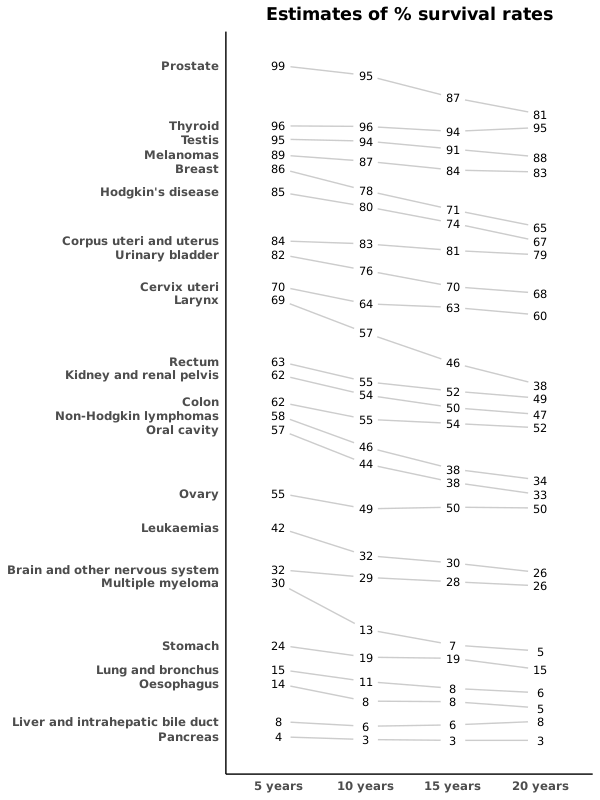
说实话,这个函数过于复杂,我已经放弃读代码了。这个代码如注释里写的,其实是参考 jkeirstead/r-slopegraph 写的。但是我也找到一个 R 包 leeper/slopegraph,这个包就已经包装得很好了,可以直接安装使用。
Seasonal Plot
涉及到时间序列对象 ts 或者 xts 的时候,forecast::ggseasonplot 可以可视化数据的季节性变化情况。下面的例子分别用了自带的时间序列 AirPassengers 和 nottem 作图:
1
2
3
4
5
6
7
8
9
10
11
12
13
14
|
library("ggplot2")
library("forecast")
theme_set(theme_classic())
# Subset data for a smaller timewindow
nottem_small <- window(nottem,
start = c(1920, 1),
end = c(1925, 12))
# Plot
ggseasonplot(AirPassengers) +
labs(title = "Seasonal plot: International Airline Passengers")
ggseasonplot(nottem_small) +
labs(title = "Seasonal plot: Air temperatures at Nottingham Castle")
|
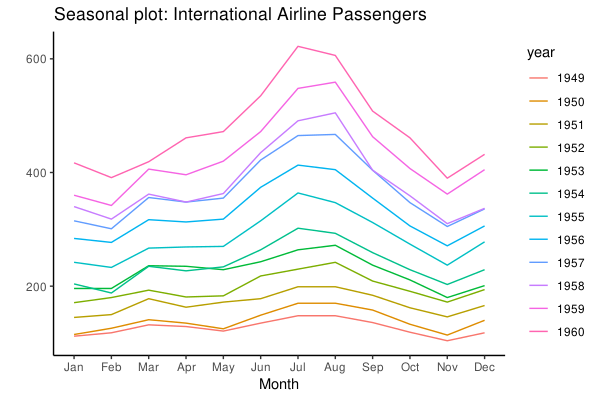
可以看到飞机乘客数是逐年上涨并且是有季节性的模式的。
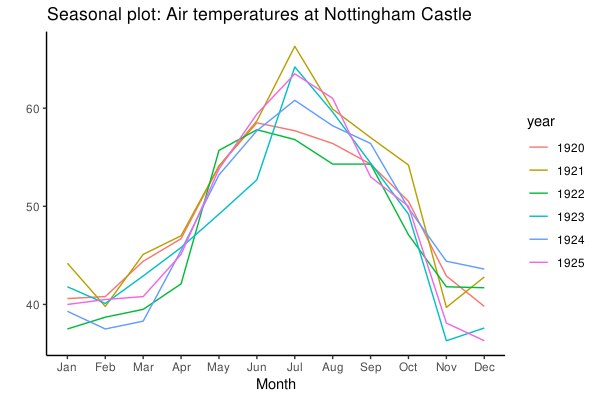
而这里天气温度虽然没有逐年上涨,但是明显是有相同的季节性变化模式的。
后面的第 7 节 Groups 里的 Hierarchical Dendrogram 图和 Cluster 都比较简单,我用的不多,略。第 8 节是 Spatial 涉及地图作图,我完全用不上,略。
用的代码:ggplot2.R
文章作者
Jackie
上次更新
2019-08-26
(c4557a2)























